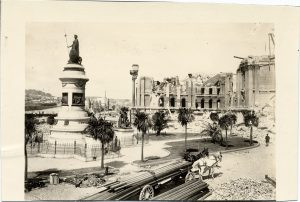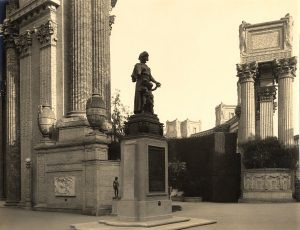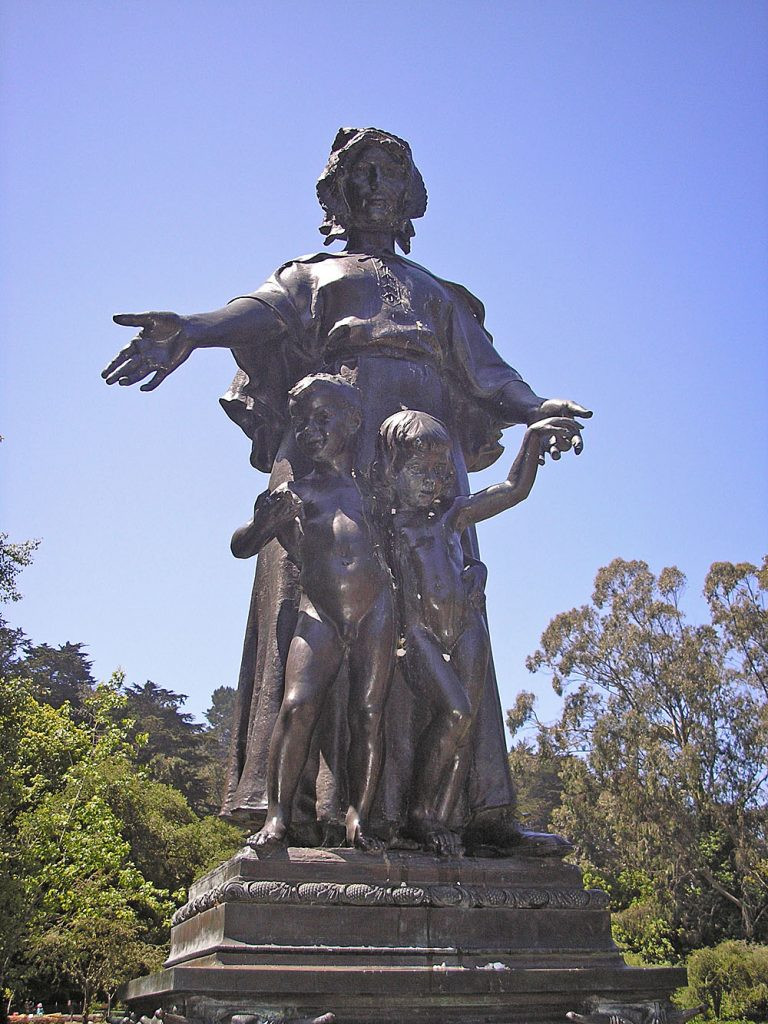Competing visions of pioneer womanhood shaped the creation of the Pioneer Mothers Memorial, a monument dedicated to early Euro-American California settlers. Originally crafted for San Francisco’s 1915 Panama-Pacific International Exposition, this tribute to pioneer women was later rediscovered and permanently installed in Golden Gate Park in 1940.

[San Francisco 1906 Earthquake Ruins with Pioneer Monument in foreground. The Pioneer Mothers Memorial idea sparked after seeing this monument. Photo: SAN FRANCISCO HISTORY CENTER, SAN FRANCISCO PUBLIC LIBRARY]
The inception of San Francisco’s Pioneer Mothers Memorial traces back to a decade prior to the 1915 exposition. Ella Sterling Mighels, a prominent San Francisco society figure, was profoundly moved by the sight of the city’s earlier Pioneer Monument standing amidst the ruins after the devastating 1906 earthquake. This powerful image ignited her vision for a monument specifically honoring pioneer mothers. Mighels passionately advocated for a memorial that would recognize pioneer women as a civilizing force in the often-chaotic environment of the California Gold Rush era. Reflecting the prevailing societal norms of her time, Mighels firmly believed that women’s influence was best expressed through motherhood and within the domestic sphere. While her vision of white womanhood resonated with many white Californians, her specific concept of the monument—depicting a seated pioneer mother imparting religious instruction (“church at her knee”)—initially met with resistance.
Despite the initial lukewarm reception to her specific artistic vision, Mighels’ dedication spurred the formation of the Pioneer Mother Monument Association (PMMA). Under the leadership of President Helen Sanborn, the association launched a fundraising campaign. Their stated goal was to erect a monument “symbolizing Motherhood, to be dedicated to the Pioneer Mothers of the West – the self-sacrificing women who, with their little ones at their side, braved the dangers and underwent the hardships and privations that are always incident to pioneer life.”[1] The PMMA envisioned a statue featuring a woman and two or three children dressed in mid-19th-century attire, possibly with a gold miner father figure incorporated in the background or as a bronze relief on the monument’s base.
Fundraising for the Pioneer Mothers Memorial statue proved challenging for Mighels and the PMMA initially. Momentum shifted when the Panama-Pacific International Exposition (PPIE) Woman’s Board became involved. Seeking to enhance the exposition’s cultural offerings, the PPIE Woman’s Board proposed featuring the monument at the 1915 world’s fair in San Francisco. The PPIE itself was conceived as a celebration of San Francisco’s resilience and recovery following the 1906 earthquake. The Pioneer Mothers Memorial was intended to complement existing monuments dedicated to California men that had withstood the earthquake, further solidifying the city’s pioneer heritage narrative.

[Pioneer Mother statue displayed at the 1915 Panama-Pacific International Exposition in San Francisco. The monument became a focal point of the fair’s art exhibits. Photo: SAN FRANCISCO HISTORY CENTER, SAN FRANCISCO PUBLIC LIBRARY]
While most structures and sculptures at the PPIE were temporary, constructed from plaster and intended for disposal after the fair, the Pioneer Mothers Memorial was conceived as a permanent fixture. Unlike The End of the Trail, a grand plaster sculpture of a male Pioneer and a Native American figure which was nearly discarded before being rescued by Visalia, California citizens, the Pioneer Mother was cast in durable bronze. This ensured its survival beyond the exposition, intended as a lasting contribution to the city of San Francisco.
The PMMA and various California pioneer societies committed to raising funds for the Pioneer Mothers Memorial project. However, tensions arose between John Trask, the PPIE’s fine arts department director, and the women’s clubs sponsoring the statue. Disagreements emerged regarding Trask’s decision to commission a prominent sculptor from the East Coast, Charles Grafly. Many women felt a California artist should have been chosen for this significant monument. Trask, a respected figure within the established fine arts community, maintained that no California artist possessed the necessary qualifications for a project of this scale and importance. He ultimately awarded the commission to Grafly, a colleague and friend.
Grafly’s artistic interpretation significantly diverged from both Mighels’ vision of a woman in hoop skirts emphasizing religious instruction and the PMMA’s concept of a pioneer woman in practical prairie attire. Instead, Grafly sculpted a figure adorned in fringed buckskin and moccasins, clothing more commonly associated with romanticized depictions of the Wild West prevalent in the East. Adding to the departure, Grafly included nude children surrounding the pioneer woman, symbolizing future generations.
Grafly’s initial design sparked considerable controversy in San Francisco due to its perceived blurring of racial and gender identities. Just a decade prior, Portland, Oregon, had embraced a Sacajawea sculpture as a tribute to white pioneer mothers. However, by 1915, San Franciscans expressed discomfort with Grafly’s portrayal of a white woman in Native American-style clothing for the Pioneer Mothers Memorial. Pressure from organizations like the Native Daughters of the Golden West and other women’s pioneer groups led Grafly to replace what was described as a “costume of a primitive Sioux Indian squaw”[2] with a more conventional homespun gown and simple leather shoes. Yielding further to donor concerns, Grafly modified the head covering, though even the revised version lacked the wide brim of typical mid-nineteenth-century sunbonnets designed to protect fair-skinned women from the sun.
Further controversy arose from Grafly’s insistence on depicting nude children in the Pioneer Mothers Memorial design. PMMA president Sanborn argued that the children’s nudity hindered public fundraising efforts for the monument, deeming it unsuitable for public sensibilities. Despite these objections, Grafly remained steadfast in his artistic vision, emphasizing the allegorical significance of the nude children at the pioneer mother’s feet. Ultimately, a compromise was brokered by philanthropist Phoebe Hearst, honorary president of the PPIE Woman’s Board, and U.S. Senator James Phelan, former San Francisco mayor. They persuaded Grafly to make the boy’s genitalia “somewhat less conspic[u]ous,”[3] thereby mitigating offense to the refined sensibilities of Anglo-American women.

[Charles Grafly’s Pioneer Mother Statue, completed in 1915, San Francisco, California. The final version reflected compromises on clothing and nudity. Photo: Public Domain]
Public reaction to the revised Pioneer Mothers Memorial statue was largely favorable. Over a thousand people visited Grafly’s studio to view the completed work, widely agreeing it was a “symbolical masterpiece.”[4] California schoolchildren across the state contributed pennies and nickels towards the monument’s erection, including substantial sums from San Francisco and Los Angeles, totaling approximately $30,000 in today’s value.
Despite being cast in bronze for permanence, the Pioneer Mothers Memorial received less fanfare at the PPIE compared to the plaster Pioneer and End of the Trail sculptures. Following the exposition, while the plaster pieces were relocated to Visalia’s Mooney Grove Park, Grafly’s bronze Pioneer Mother was unfortunately neglected and seemingly forgotten. A quarter of a century later, the monument was rediscovered in a state of disrepair, weathered and vandalized, amidst the decaying Palace of Fine Arts. Within three months of its rediscovery, civic and historical organizations rallied to restore the Pioneer Mothers Memorial. It was briefly displayed at the Golden Gate International Exposition before finally being permanently installed in a meadow within Golden Gate Park on December 8, 1940, where it stands as a lasting, if sometimes overlooked, monument to pioneer women.
Related Monuments:
Frank Happersberger, Lick Pioneer Monument, 1894
Douglas Tilden, Admission Day Monument, 1897
Solon Borglum, American Pioneer, 1915-1980
James Earle Fraser, End of the Trail, 1915
Explore:
San Francisco Pioneer Monuments Walking Tour powered by Clio
Northern California Pioneer Monuments Driving Tour powered by Clio
Notes:
[1] “Motherhood Monument.” The Journal of Education 80, no. 9 (September 17, 1914): 240.
[2] “Pioneer Mother Draped Like a Sioux Squaw.” San Francisco Chronicle undated clipping. Charles Grafly Papers, Wichita State University Libraries Special Collections.
[3] Telegram from Phoebe A. Hearst to Charles Grafly, December 31, 1914, Charles Grafly Papers box 7, folder 20, Wichita State University Libraries Special Collections.
[4] “Viewed Sculptor’s Masterpiece: Thousands Impressed With ‘Pioneer Mother’ at the Grafly Studio,” Gloucester Daily Times, October 19, 1914, Charles Grafly Papers.
